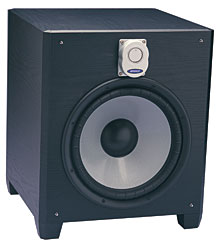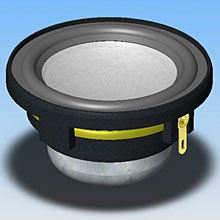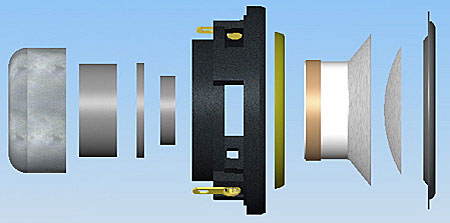Energy Reference Connoisseur RC-70 Surround Speaker System Page 2
 I would rate the useful bass extension at no lower than 30Hz. The measurements (which I have not yet seen as I write this) might show it to be a little lower (the rated -10dB point is 26Hz), which wouldn't surprise me. On most conventional programming the bottom end sounds solid and deep. Percussive drum impact is convincing. There's a firm underpinning to most types of music. But organ fans might want to look elsewhere—or to a good subwoofer. The organ foundation on good recordings of works such as Respighi's The Pines of Rome just isn't there.
I would rate the useful bass extension at no lower than 30Hz. The measurements (which I have not yet seen as I write this) might show it to be a little lower (the rated -10dB point is 26Hz), which wouldn't surprise me. On most conventional programming the bottom end sounds solid and deep. Percussive drum impact is convincing. There's a firm underpinning to most types of music. But organ fans might want to look elsewhere—or to a good subwoofer. The organ foundation on good recordings of works such as Respighi's The Pines of Rome just isn't there.
While bass overload on most music is not a problem, if you play your home theater soundtracks at fighting levels you'll want a good subwoofer to go with the RC-70s. That's no surprise. It's true of most full range speakers smaller than a refrigerator.
I was pleasantly surprised by the performance of the Energy S12.3 subwoofer. The (relatively) lightweight construction captive power cord, and bland black ash vinyl finish didn't promise magic. But the money has obviously been spent where it counts: on the inside.
The RC-70s and the S12.3 blended beautifully using an 80Hz crossover in the Anthem D1 pre-pro used in the review. The sub's bass extension was superb. The only subwoofer I've used recently that can clearly beat it in overall performance is the Revel B15—which also gives you three bands of built-in parametric bass equalization for its $3295 price.
When I compared the S12.3 directly to the Hsu VTF-3 ($875, sold only factory direct on the Internet) the Energy went deeper and sounded cleaner and more detailed, most notably in the midbass. Obviously, the two subs could not occupy the same space at the same time for this comparison, but were positioned side-by side and as close into the room corner as I could get them simultaneously. Slight differences in positioning can alter the sound of a subwoofer, but when I reversed their positions (as much as possible) the essential sonic differences remained.
 I had occasionally wished for a little from the RC-70s in dynamic range department, but the addition of the subwoofer largely belayed that desire. There are speaker systems that will play louder and, presumably, better fill a space larger than my 3200 cubic foot home theater room, but with the subwoofer added the Energy system was as dynamic as I needed, and played louder than I would ever want to push it.
I had occasionally wished for a little from the RC-70s in dynamic range department, but the addition of the subwoofer largely belayed that desire. There are speaker systems that will play louder and, presumably, better fill a space larger than my 3200 cubic foot home theater room, but with the subwoofer added the Energy system was as dynamic as I needed, and played louder than I would ever want to push it.
Putting it Together
My first reaction to the RC-LCR center channel was distress. It didn't seem to match the sound of the RC-70s at all. More to the point, it sounded bloated and colored. But it hadn't had as much run-in as those big floor-standers. So while I waited to find the time for additional break-in, I used a Revel M22 as a center channel. It didn't match the RC-70s in timbre either, but actually blended into the front soundstage on movie soundtracks far better than I might have imagined. That was the setup I used in the review of the Outlaw Model 7125 amplifier (along with the Hsu subwoofer—the S12.3 also needed a little more seasoning at the time).
When I came back to the RC-LCR for this report after breaking it in further, most of that early bloat had vanished. It was one of the most significant transformations I have ever heard in a speaker's sound following break-in. (The importance of speaker break-in is accepted by most audiophiles, but it remains somewhat controversial). Some dialogue still sounded a little over-full, but it was now a sometime thing, varying from program to program. The center could also sound a little reticent off-axis (I often sit slightly off-axis during movie watching to give my projector rack a clear shot at the screen), but the blending of the three front speakers was now hard to criticize.
I also experimented with both the positioning and setup of the RC-R surrounds. The location at the back of the room ultimately sounded best. While the reproduction of ambience and other surround effects was a little more effective with the RC-Rs positioned high and to the sides in my relatively narrow (15.5' wide) home theater space, other aspects of their sound were not. When located at the sides the surrounds were sometimes too prominent, and at high levels I sometimes heard a trace of overload that was not audible when they were positioned behind me.
I also found that the RC-Rs were not very effective as dipoles. While there was a clear change in timbre when I switched the RC-R from bipole to dipole mode, I could not hear the clear on-axis null required for a dipole surround to work properly. I settled on bipole operation for my listening.
When finally firing on all cylinders, the Energy Reference Connoisseur system produced multichannel movie sound that was exciting, immersive, and rewardingly cinematic. Whether that sound was the ambience and envelopment of the concert at the Los Angeles Coliseum in Simone (an excellent soundtrack and a good concept for a film, done-in by Al Pacino's over-the-top mugging), the well recorded songs and (mostly—though sometimes slightly bright) music score on The Road to El Dorado, the savage drums and often surprisingly subtle effects in almost any episode of the new Battlestar Galactica TV show (but only on its DVD releases, not on the lackluster audio and video you'll see and hear in the Sci-Fi Channel's cablecasts), or the lush, sweeping orchestral score in National Treasure (which can be too bright and edgy on many speakers, but sounds right on the Energys), the system never let me down. If you listen directly on-axis, you may occasionally hear a touch of metal dome brightness, particularly on less than pristine soundtracks. But with the speakers toed in as described in the setup, that was a rare occurrence in my system.

Energy 2" Midrange Exploded View
Since I do sit slightly off-axis for movie watching, I paid particular attention to the sound of the center channel speaker. While my previous experience suggests that such a horizontally configured speaker will exhibit off-axis response anomalies (despite the unusual mid-tweeter diagonal array used here to minimize it), I was not bothered by odd response-dip colorations in my normal, seat (roughly equivalent to one side of a three-seat sofa about 10 feet from the speaker). My off-axis position also slightly reduced the occasional excess vocal sibilance not uncommon with over-processed soundtracks.
What about the bass? The S12.3 subwoofer continued to impress me on soundtracks. From the cacophonous roar of the sandstorm in the remake of Flight of the Phoenix to the subterranean rumble of the alien war machines emerging from the ground in the new War of the Worlds, the Energy sub generated an appropriate sense of dread and disquiet that the Hsu (while still an excellent subwoofer and a good value in its own right) did not.
Conclusions
It seems only a few years ago (OK, the early 1990s) that $2000/pair was the sweet spot for serious audiophile speakers. Add in a matching center channel, surrounds, and a sub, and you were still under $5000. Today, all bets are off. But it's still possible to buy a first-class surround speaker system for that price, a system that performs equally well on both soundtracks and music. The Energy Reference Connoisseur system proves it. Highly recommended.
Highs and Lows
Highs
Superb sound
Excellent fit and finish
Subwoofer rocks
Lows
Needs an extended break-in, particularly the center channel, for best performance





























































